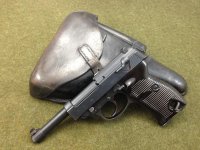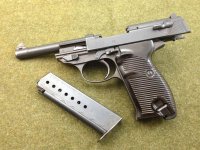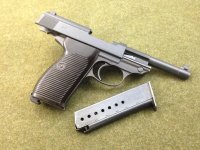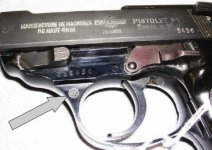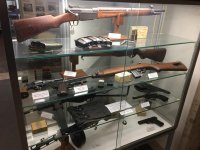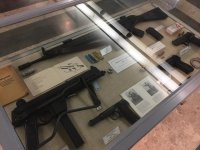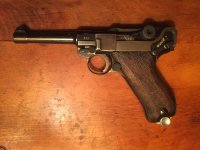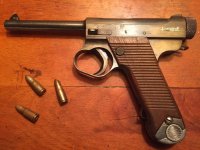I have an out of state friend looking at a 1944 P-38. I know there were three manufacturers and they used codes to identify the makers. anyone got a list of those codes? thanks in advance. lee
You are using an out of date browser. It may not display this or other websites correctly.
You should upgrade or use an alternative browser.
You should upgrade or use an alternative browser.
need help with ID on P-38
- Thread starter Lee Barner
- Start date
Register to hide this ad
DocB
Member
The CYQ is worth far less than the other two. Lots of them floating around right now . . .surplus sell offs. Generally, Walther is the most in demand of the three. Mauser is close behind. Mauser was late to produce the P-38 since they were so devoted to the Luger. They also didn't like having to make the P-38's when forced to. The CYQ's tend to be later-war and bit junky. In today's market, I would pay $300 for a nicer CYQ, $600 for a nice Mauser, and $700 for a Walther. Anyone wanting more has a screw loose unless the gun has rare markings.
thanks guys. that's what I needed to know. lee
I will agree the finish on the CYQ's generally is not as nice as the Walthers or Mausers. When I found this gun in a pawn shop my first thought was, "this is the nicest CYQ I've ever seen." It was a vet bringback and it came home in a Luger holster. It was in virtually mint, unfired, condition. I sold it about 2 years ago, to a collector, for $1,000. Not as nicely finished as the others, maybe, but when found in the condition this one was in, it drives the value WAY up. I'm glad it found a nice home.
Attachments
Last edited:
Regarding the values that were given for a Spreewerke marked pistol, I want to point out that I sold a P.38v magazine for $150 this month and had sold original P.38 grips for $175 lately. I do not expect to find an original, complete and correct WWII P.38 in good to very good condition under $550.
DWalt
Member
Regarding the values that were given for a Spreewerke marked pistol, I want to point out that I sold a P.38v magazine for $150 this month and had sold original P.38 grips for $175 lately. I do not expect to find an original, complete and correct WWII P.38 in good to very good condition under $550.
From prices I see, $550 today would be somewhat of a giveaway price for any P-38 in original reasonable condition from any maker, unless it is being sold by someone with no knowledge of P-38s (such as a WWII vet's widow). I have a fairly high condition byf-44 with original soft leather P-38 holster and two mags I was recently offered $1200 in cash for, but I am not looking to sell it just yet. If I do sell it, it will be for more than $1200.
Last edited:
You won't find much in the $500 range in war time P38's anymore.
The collectors are savy with all the info around now. Some of the small variations bring bigger $$ when they all look the same as the rest of them to the average shooter. Not unlike most other areas of collecting,
Early production Mauser/BYF '42 will easily bring twice what a Walther AC 44 or 45 does. First year, only partial year production. Just one example.
On the other side, early Walther banner marked pistols and Zero series guns are much sought after prizes and price tagged as such.
(I wish my Dad hadn't sledgehammered the Walther banner P38 to pieces he brought back from WW2, but that's old history now)
CYQ are no longer the 'junk' or slave labor guns. They bring some good money too and lot's of collector variations in parts have surfaced.
Even a postwar P1 is no longer the $149.99 alloy frame alternative to the real thing. Check the prices on those of late.
Everything is a 'collectible' now and priced accordingly.
The collectors are savy with all the info around now. Some of the small variations bring bigger $$ when they all look the same as the rest of them to the average shooter. Not unlike most other areas of collecting,
Early production Mauser/BYF '42 will easily bring twice what a Walther AC 44 or 45 does. First year, only partial year production. Just one example.
On the other side, early Walther banner marked pistols and Zero series guns are much sought after prizes and price tagged as such.
(I wish my Dad hadn't sledgehammered the Walther banner P38 to pieces he brought back from WW2, but that's old history now)
CYQ are no longer the 'junk' or slave labor guns. They bring some good money too and lot's of collector variations in parts have surfaced.
Even a postwar P1 is no longer the $149.99 alloy frame alternative to the real thing. Check the prices on those of late.
Everything is a 'collectible' now and priced accordingly.
Last edited:
Photog
Member
To the gentleman who posted that a nicer CYQ would be about $300 in today's market, I have an offer. I have a Mauser and a Walther in my collection. I want to add a CYQ. So If you can find me a nicer one for $300, I will pay you a $100 finders fee. Let me know.
BigBill
Absent Comrade
Years ago I picked up a P1 waltzer I believe. It’s the alloy frame police version of the p38. P38’s just demand too much money. It’s new still unshot in the box.
LVSteve
Member
To the gentleman who posted that a nicer CYQ would be about $300 in today's market, I have an offer. I have a Mauser and a Walther in my collection. I want to add a CYQ. So If you can find me a nicer one for $300, I will pay you a $100 finders fee. Let me know.
I would also like to know where this large stack of $300 P-38s resides.
Years ago I picked up a P1 waltzer I believe. It’s the alloy frame police version of the p38. P38’s just demand too much money. It’s new still unshot in the box.
P1 is the post war German military designation for the P38. Commercial models kept the P38 marking.
Small arms production in post war German was extremely limited, until 1957.
Beginning in 1957 the P.38 was adopted as the West German military service pistol and the order was produced in 1958 on new tooling, but using an alloy frame. All of these 1958 production pistols were stamped "P.38", and it was the standard issue pistol until 1963.
In 1963, additional pistols made for the West German Bundeswehr were stamped "P1" - but it was the same post war, alloy framed "P.38" pistol.
There are basically four major categories that these pistols fall into:
1) Wartime produced P.38s (by Walther, Mauser and Spreewerke) with steel frames.
2) The initial post war (1958) production batch of military P1 pistols with alloy frames but marked "P.38"; and
3) The later (1963 and after) Bundeswehr and West German police pistols with alloy frames marked "P1". The military pistols were also stamped "BW" for "Bundeswehr" after the serial number. There were two improvements made to these pistols both in new production and factory refurbished pistols:
In the late 1960s a thicker slide was introduced to address issues with slides stretching and cracking around the locking lug cutouts, due to the use of higher pressure ammunition including 9mm NATO and higher pressure ammunition used by the West German Police.
In 1975, a hex lug was added to extend the service life of the frame by providing a hardened steel wear surface for the locking cam.
4) Post war commercial models marked "P.38" with aluminum frames.
The commercial P.38s are distinct from the 1958 batch of "P.38" marked military pistols as the commercial pistols do not have any military or police markings. The commercial models never received the hex bolt, and all the heavy slides were military or police, and were marked "P1".
Consequently, If you see a commercial slide on a hex bolt frame, or if you see a heavy P1 slide on a commercial frame, it's a parts gun.
If it's a military or police gun, the slide and frame will be numbered and if the numbers don't match, it's once again a parts gun.
----
As noted above, while the CYQ marked pistols made by Spreewerke don't bring quite as high a price as an early war Walther (ac) or Mauser (bfy) marked pistols, it's a relative thing. With all matching numbers, correct grips and in very good condition, a CYQ will bring about $800, compared to maybe $1000 for a ac or byf, or perhaps $1200 for an early production ac or byf in similar condition.
Post war commercial P.38s and P1s can still be found for $450-$500 in excellent condition, but the prices are going up.
Since wartime P.38 loses about half it's value if the numbers don't match, you can also find non matching war time P.38s in very good condition for around the same $450-$500 price range.
You will almost never find a P.38 or P1 in good solid shootable condition for less than about $400-$450 as they all have some intrinsic value as shootable examples of an iconic design. If you're looking for a great value and turn your nose up at a $400 P.38 or P1, you'll either need to be very lucky or resign yourself to never owning one.
And, of you're reading this 2-3 years after this was posted, you can expect to pay more for these pistols as surplus pistols have dried up and the days of the $200 P1 are already several years in the past.
Beginning in 1957 the P.38 was adopted as the West German military service pistol and the order was produced in 1958 on new tooling, but using an alloy frame. All of these 1958 production pistols were stamped "P.38", and it was the standard issue pistol until 1963.
In 1963, additional pistols made for the West German Bundeswehr were stamped "P1" - but it was the same post war, alloy framed "P.38" pistol.
There are basically four major categories that these pistols fall into:
1) Wartime produced P.38s (by Walther, Mauser and Spreewerke) with steel frames.
2) The initial post war (1958) production batch of military P1 pistols with alloy frames but marked "P.38"; and
3) The later (1963 and after) Bundeswehr and West German police pistols with alloy frames marked "P1". The military pistols were also stamped "BW" for "Bundeswehr" after the serial number. There were two improvements made to these pistols both in new production and factory refurbished pistols:
In the late 1960s a thicker slide was introduced to address issues with slides stretching and cracking around the locking lug cutouts, due to the use of higher pressure ammunition including 9mm NATO and higher pressure ammunition used by the West German Police.
In 1975, a hex lug was added to extend the service life of the frame by providing a hardened steel wear surface for the locking cam.
4) Post war commercial models marked "P.38" with aluminum frames.
The commercial P.38s are distinct from the 1958 batch of "P.38" marked military pistols as the commercial pistols do not have any military or police markings. The commercial models never received the hex bolt, and all the heavy slides were military or police, and were marked "P1".
Consequently, If you see a commercial slide on a hex bolt frame, or if you see a heavy P1 slide on a commercial frame, it's a parts gun.
If it's a military or police gun, the slide and frame will be numbered and if the numbers don't match, it's once again a parts gun.
----
As noted above, while the CYQ marked pistols made by Spreewerke don't bring quite as high a price as an early war Walther (ac) or Mauser (bfy) marked pistols, it's a relative thing. With all matching numbers, correct grips and in very good condition, a CYQ will bring about $800, compared to maybe $1000 for a ac or byf, or perhaps $1200 for an early production ac or byf in similar condition.
Post war commercial P.38s and P1s can still be found for $450-$500 in excellent condition, but the prices are going up.
Since wartime P.38 loses about half it's value if the numbers don't match, you can also find non matching war time P.38s in very good condition for around the same $450-$500 price range.
You will almost never find a P.38 or P1 in good solid shootable condition for less than about $400-$450 as they all have some intrinsic value as shootable examples of an iconic design. If you're looking for a great value and turn your nose up at a $400 P.38 or P1, you'll either need to be very lucky or resign yourself to never owning one.
And, of you're reading this 2-3 years after this was posted, you can expect to pay more for these pistols as surplus pistols have dried up and the days of the $200 P1 are already several years in the past.
Absalom
SWCA Member, Absent Comrade
Nice summary, BB57.
The only variant you forgot to mention are the P1s stamped “Pistolet P 1” and “Made in France”, which are relevant to the US collector because most of them ended up here, and at any given time you can find at least half a dozen on offer on Gunbroker.
Sometimes they are labeled as “Walther clones”. They are nothing of the kind. They are perfectly good German-made P1s, produced in the early 1960s, which were shipped in the white to Manurhin to be stamped, finished and proofed, and then shipped back to Germany, specifically for West Berlin authorities who were prohibited by special four-powers rules to carry weapons made in Germany until the 1970s.
These don’t have the hex bolt, but have the Berlin police star in front of the trigger guard. Very rare are the 600 pistols ordered for the West Berlin customs service, which have a BUND stamp on the right.
(Note: Photo not mine, lifted off the web)
The only variant you forgot to mention are the P1s stamped “Pistolet P 1” and “Made in France”, which are relevant to the US collector because most of them ended up here, and at any given time you can find at least half a dozen on offer on Gunbroker.
Sometimes they are labeled as “Walther clones”. They are nothing of the kind. They are perfectly good German-made P1s, produced in the early 1960s, which were shipped in the white to Manurhin to be stamped, finished and proofed, and then shipped back to Germany, specifically for West Berlin authorities who were prohibited by special four-powers rules to carry weapons made in Germany until the 1970s.
These don’t have the hex bolt, but have the Berlin police star in front of the trigger guard. Very rare are the 600 pistols ordered for the West Berlin customs service, which have a BUND stamp on the right.
(Note: Photo not mine, lifted off the web)
Attachments
italiansport
Member
Nice summary, BB57.
The only variant you forgot to mention are the P1s stamped “Pistolet P 1” and “Made in France”, which are relevant to the US collector because most of them ended up here, and at any given time you can find at least half a dozen on offer on Gunbroker.
Sometimes they are labeled as “Walther clones”. They are nothing of the kind. They are perfectly good German-made P1s, produced in the early 1960s, which were shipped in the white to Manurhin to be stamped, finished and proofed, and then shipped back to Germany, specifically for West Berlin authorities who were prohibited by special four-powers rules to carry weapons made in Germany until the 1970s.
These don’t have the hex bolt, but have the Berlin police star in front of the trigger guard. Very rare are the 600 pistols ordered for the West Berlin customs service, which have a BUND stamp on the right.
(Note: Photo not mine, lifted off the web)
I have one of the Manurhin examples in mint condition and believe me it would take a lot more than $300 to buy it! It was made in 1967 and imported by Interarms. The days of relatively inexpensive P38s even post war examples in original unmessed with condition is long gone.
Jim
Last edited:
I guess you should throw in the code 'SVW' and '480'.
The 'SVW' are late War mfg Mauser P38 pistols and some post-war pistols assembled under French control of the Mauser factory.
Mauser changed their factory mfg code from BYF to SVW on the marking on the side some time in 1945,,I don't recall when exactly.
The French assembled pistols with this code marking thru at least mid 1946,,maybe a bit later.
'480' code marked pistols are simply early production Walther P38's.
Before the 'ac' code was assigned,,the code marking '480' was used the same way starting in 6/40.
'480' pistols snag a premium.
Before the '480' code was used, the issue pistols were Walther Banner marked.
The first bunch issued for service are called 'zero series' as their ser# all have a zero prefix.
The pistols have a few details that set them apart from later production. These only lasted for about a year starting in mid 1939 till the '480' code marking was ordered to procede in June/40.
The commercial sales version of the German Issue P38 was called the HP series Walther.
One Military contract for the HP went to Sweden in 1939. I don't believe they were all delivered.
Made in 9mm and 30cal
Any of the early pistols are a rare find and valuable.
A very small number of early design hammerless models called the 'AP series' pistols was made (around 50) in 1935/36. The German Gov't decided on the external hammer model instead and we have the P38/HP
The collector field widens!!
The 'SVW' are late War mfg Mauser P38 pistols and some post-war pistols assembled under French control of the Mauser factory.
Mauser changed their factory mfg code from BYF to SVW on the marking on the side some time in 1945,,I don't recall when exactly.
The French assembled pistols with this code marking thru at least mid 1946,,maybe a bit later.
'480' code marked pistols are simply early production Walther P38's.
Before the 'ac' code was assigned,,the code marking '480' was used the same way starting in 6/40.
'480' pistols snag a premium.
Before the '480' code was used, the issue pistols were Walther Banner marked.
The first bunch issued for service are called 'zero series' as their ser# all have a zero prefix.
The pistols have a few details that set them apart from later production. These only lasted for about a year starting in mid 1939 till the '480' code marking was ordered to procede in June/40.
The commercial sales version of the German Issue P38 was called the HP series Walther.
One Military contract for the HP went to Sweden in 1939. I don't believe they were all delivered.
Made in 9mm and 30cal
Any of the early pistols are a rare find and valuable.
A very small number of early design hammerless models called the 'AP series' pistols was made (around 50) in 1935/36. The German Gov't decided on the external hammer model instead and we have the P38/HP
The collector field widens!!
Absalom
SWCA Member, Absent Comrade
I guess you should throw in the code 'SVW' and '480'.
The 'SVW' are late War mfg Mauser P38 pistols and some post-war pistols assembled under French control of the Mauser factory.
Mauser changed their factory mfg code from BYF to SVW on the marking on the side some time in 1945,,I don't recall when exactly.
The French assembled pistols with this code marking thru at least mid 1946,,maybe a bit later.
...........
The collector field widens!!
The SVW 45 and SVW 46 marked P38s made by Mauser under French direction were actually some of the first Walthers the Berlin police got, the French contribution to a hodgepodge of occupation-provided police armaments including Spanish Astras, American 1911s, US and BSR Victorys, Enfields, and an assortment of longarms.
They didn't standardize on the Manurhin P1 (and the Manurhin PPK for plainclothes) until 1963/64. Some of the post-war gun menagerie is on display now in the historical collection of the Berlin police.
Attachments
Small arms production in post war German was extremely limited, until 1957.
....
I want to add, that in the wake of WWII Germany wasn't allowed arms production until 1952 when smooth bore firearms were allowed to be manufactured and from 1953 on the manufacturing of rifled barrels was possible once again. From then on a real boom of manufacturing sporting guns started.
The restricitions on military arms were lifted later and also led to the development of the G3 by German engineers at CETME in Spain, the production resumed there even after Rheinmetall was awarded the patent rights of the roller lock..
Last edited:
DocB
Member
Maybe I've let too many of the CYQ guns go by this year. . .three to be exact, all in the $400-$450 price range. I also pass on mismatched Lugers in the $600-$700 range. Last P-38 I bought was in 2010. It was a near mint BYF, vet bring back, and had the original holster. Those are the reasons I paid $500 for it. Passed on a Walther that same day for the same price because it was a little rough and lacked the holster. The year before I picked up matching Luger that had some finish wear issues on the left side. . .paid $350 for it. I call it a shooter. I guess all the vets must have settled in Georgia, because these things turn up all the time. Even this Jap Nambu was $450. I paid that because it is a "complete" outfit that came with the transfer papers. It's literally mint and was picked up by a black private on Iwo Jima. That added some value to me since not a lot of black guys were allowed to fight in the Pacific.
Attachments
DWalt
Member
I imagine some here also remember the time when you could walk into any pawnshop in America and find P-38s and Lugers on display priced at $25. Nambus? You could hardly give them away.
Similar threads
- Replies
- 3
- Views
- 396
- Replies
- 3
- Views
- 249
- Replies
- 19
- Views
- 2K
- Replies
- 3
- Views
- 232

